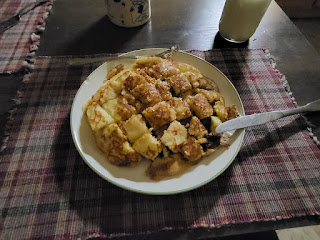Sharpening Curved Blades
"A promise is a promise," Call said. "A promise is words-a son is a life," Clara said.
Lonesome Dove, Larry McMurtry
So a couple things. First off I just finished Lonesome Dove and all I can say is wow. An absolutely amazing book Larry McMurtry is a true master.
The second thing is the post that follows was supposed to be published by Fine Woodworking but then covid happened then the editors changed then they evidently published a similar article by a much better known builder/author and mine got scuttled which was disappointing but life goes on. the double spaced text below is from the original proposal then the regular centered text if mine from today.
Sharpening curved blades
When I started building Windsor chairs after years of building mostly square
pieces (dressers, blanket chests and the like) I realized that one of the biggest
challenges was learning how to sharpen tools with curved blades like scorps (in
shaves), compass planes, heel shaves and the like.
Initially I read all the books and did what they instructed, which was mostly
automotive sandpaper wrapped around dowels or pipes of roughly the same size
or free hand paddles on the face. I was used to sharpening straight blades like
plane irons or chisels using a couple different jigs and waterstones for fast,
consistent results. I heard once that sharpening without a jig is like shooting a rifle
without sights. You do occasionally hit what you’re aiming at, but it’s literally hit
and miss. So, after years using dowels and sandpaper freehand on my curved
blades with slow inconsistent results, I decided to apply the rational of jigs to
curved blades. The result is a fast, consistent, repeatable way to sharpen curved
blades in the same way that my various jigs sharpened straight blades.
Over the course of a couple years I was able to develop jigs, holders and methods
that allow repeatable and safe ways to sharpen everything from scorps to
travishers to carving tools in ways that are fast, safe and repeatable.
Tool that makes this all work is this strip sander from Lee Valley. I had this for a few years and used it solely to sharpen kitchen knives. The problem is the table only goes to 90 degrees and in order to sharpen scorps or travisher blades it needed to go past 90 sometimes way past 90. So when I looked at sharpening the scorp I came up with a simple pine (or whatever wood) block clamped to the top of the table. Then by tipping the table towards me, the block of wood became the new "tool rest" and then I could hit any angle I needed. Later I added the plywood top that makes the rest bigger and also aids in clamping it on. I may someday bolt it on to avoid clamps. One important note is I removed the back platen which allows the strip to flex on the curved blade.
The above pic shows how the Lee Valley strip sander without the wooden block lands at 90 (actually mine lands at like 5 degrees short of 90) and thus renders it useless for the scorp.
Here you can see the block clamped on the aluminum table (or tool rest) and rolled back to 10 (or 80) degrees using a bevel gauge.
The below picture shows how the sanding strip now rubs perfectly on the bevel of the scorp.
You can also use the same setup to sharpen travisher blades (the pieces of wood used to hold the blade idea I got from Pete Galbert). The blades are fastened to the block of wood with small wood screws and the pieces of wood matches the arc of whatever travisher you're using. This is a fairly flat travisher I built awhile back.
The blade is screwed to the wooden holder and passed over the sanding strip. I usually go from a 400 grit belt and end with a 9u which I think is around 1500 which is razor sharp.
Then is put the blade on the other end of the holder and turn the burr off and it is absolutely razor sharp.
Here you can see how by using a marker it left just a whisper of the hollow grind. I get my strips from sharpeningsupplies.com and keep them hanging next to the sander which has a permanent spot on the bench. I usually start with a 600 grit and end at 6u. The last 2 pictures show the motor and switch setup for the sander. And yes I still use it to sharpen kitchen knives.





























